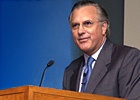 This is Richard W. Fisher’s speech on News & Events – Federal Reserve Bank of Dallas:
This is Richard W. Fisher’s speech on News & Events – Federal Reserve Bank of Dallas:
As you contemplate them, you might start by putting China’s economy in context. One can paint two starkly different pictures of China right now, the Big China view and the Little China view. The Big China view centers on China’s manpower and prowess in manufacturing, and it uses purchasing-power-parity adjusted dollars to embolden its case, a convention adopted by economists to adjust for local purchasing power, which has its utility but may or may not be a useful tool in measuring comparative geopolitical power. Here are some statistics to support the Big China view:
* America has a labor force of 147 million; China’s is 761 million”five times as large.
* China’s factories produced just 200 room air conditioners in 1978; today, they produce 48 million. Back then, they turned out just 11 billion meters of cloth; last year, 35.4 billion meters (over 3 times as much).
* Chinese households have a rapidly increasing abundance of appliances and electronic products”refrigerators, TVs, DVDs, cell phones, etc.”at ownership rates not far below those in this country.
* They have 28.3 million broadband users and 98.8 million Internet users, according to their Ministry of Information and Industry.
* There are 28 billion square feet of floor space under construction in China, compared with just 5 billion in the U.S. Five of the world’s largest shopping centers are now located in China.
* The U.S. manufacturing sector produced goods worth $1.5 trillion in 2004; China’s produced $3.4 trillion, adjusted for purchasing power parity.
* And the grand statistic of them all : On a purchasing-power-parity adjusted basis, economists put China’s gross domestic product at $7 trillion, compared with our $12 trillion”making it already 60 percent of our size. That’s the Big China view.
The Little China view has many more statistics in its support:
* U.S. productivity in agriculture is 33 times that of China; productivity in U.S. industry is five times that of China.
* The U.S. has 19,497 airports; China, just 126.
* We have 150,000 miles of petroleum pipelines; they have less than 10,000.
* We have 481 cars per 1,000 people; they have seven.
* We have much, much higher levels of education, technology I could go on and on with statistics to show where China comes up short. But here are two good summary statistics: On a straight U.S. dollar basis (not adjusted for purchasing power parity), their economy is roughly the size of California’s! China’s GDP per person is just $1,300, compared with our nearly $40,000. That’s just 1/30 of our per capita GDP. I personally think we overstate the current prowess of China by emphasizing the Big China view. But from either perspective, China has room to grow. To do so, they will have to deal with infrastructure and other problems, which present significant challenges.







